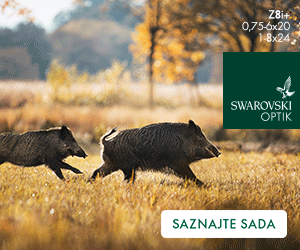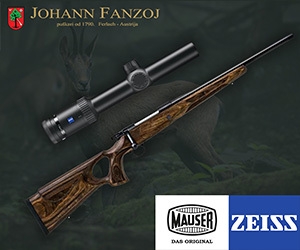FCI Standard: 150 / 25. 03. 2003.
FCI Klasifikacija:
Grupa: 6 - Goniči i srodne pasmine
Sekcija: 1 - Goniči
Podsekcija: 2 - Psi srednje veličine
Sa radnim ispitom.
Zemlja porijekla: Srbija i Crna Gora
Upotreba: Pouzdan, veoma istrajan gonič.
Opći izgled: Pas srednje veličine, robusne mišićave konstrukcije. Čvrstog karaktera, živ i energičan. Tijelo malo duguljasto sa proporcijom dužine većom od 10% u odnosu na visinu. Jak vrat, klinasta njuška malo kraća nego lubanja. Snažna čeljust sa normalnim škarastim zubima. Podgriz dozvoljen. Oči srednje veličine sa rubovima poklopaca i zjenicama što tamnije boje (svijetle oči su eliminirajući faktor). Noge jake, mišičave i paralelne sa elastičnim i otpornim jastučićima šapa. Kanđe crne. Osnovne boje ove rase su smeđe-crvena koja se kreće od žuto-crvene do rustikalne sa crnim plaštom ili sedlom. Plašt ili sedlo ide od glave sa crninom na svakoj strani sljepoočnica; na prsima dozvoljene bjeline ne veće od 2 cm u prečniku. Dlaka kratka, obilna, jaka, prilično debela i dobro leži na tijelu sa poddlakom. Dlaka nešto duža na zadnjoj strani butina i ispod repa. Uši su visoko postavljene, srednje širine i dužine, tanke, vise blizu obraza. Vrhovi ušiju malo ovalni. Mužjaci dostižu dužinu od 46 -56 cm, idealno između 51 i 52 cm a ženke 44 -54 cm, idealno između 48 i 49 cm.
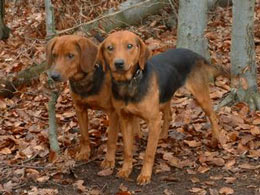 |
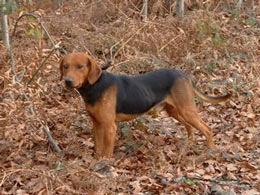 |
Rasa pripada grupi goniča koja je raširena cijelim Balkanom. Važeće je mišljenje da je su Azijski goniči odigrali veliku ulogu u genetici ove rase. Prvi opis ove rase pod imenom Balkanski gonič potječe iz 1905 godine. Prvi standard je utvrđen 1924. godine, ali je tek na zasjedanju FCI-a u svibnju 1940. godine usvojen. U studenom 1996. godine, na sjednici u Kopenhagenu, Generalni komitet FCI-a je odlučivao o stavu tadašnjeg JKS-a i prihvatio njihov zahtjev da se ime pasmine promijeni u Srpski gonič, što je danas službeno ime pasmine.
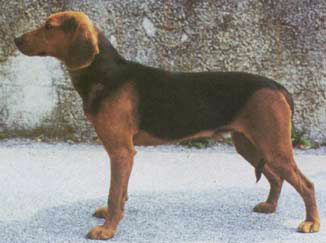
Srpski Gonič - Serbian Hound - Balkanski gonič - Balkanbracke - Balkánský honič
FCI-Standard N° 150 / 05. 05. 2003 / GB
SERBIAN HOUND
( Srpski Gonič )
TRANSLATION : Mrs Pamela Jeans-Brown.
ORIGIN : Serbia and Montenegro.
DATE OF PUBUCATION OF THE ORIGINAL VAUD STANDARD : 25.03.2003.
UTILISATION : Scent hound.
CLASSIFICATION FCI : Group 6 Scent hounds and related breeds.
Section 1.2 Medium sized scenhounds With working trial.
BRIEF HISTORICAL SUMMARY : The breed belongs to the group of scent hounds which have spread throughout the Balkan territory. It is thought that the scent hounds from Asia Minor played an important part in its genesis. The first description of this breed under the name of Balkan scent hound dates from 1005 ; for this we are endebted to Frank Laska who described this breed together with other scent hounds. The first standard was drawn up in 1924 , but it was only at its session in Bled on May 14th 1940 that the F.C.I. adopted the standards already announced in Stockholm in 1939 and among these was included that of the Balkan scent hound. Because the breed was most widespread in Serbia, it was the Yugoslav Cynological Association which controlled breeding and put in place the first registrations in the official stud book. On November 12th 1996,during its meeting in Copenhagen, the General Committee of the F .C.I. discussed the motion put forward by the annual general meeting of the Yugoslav Cynological Association, and accepted that the name Balkan scent hound be replaced by Serbian hound.
GENERAL APPEARANCE : Dog of medium size with a robust constitution. Full of character, it is lively and energetic.
IMPORTANT PROPORTIONS:
· Length of body measured from point of shoulder to point of buttock is 10% greater than height at withers.
· Girth of chest is 20% more than height at withers. Length of head corresponds to 45% of height at withers.
BEHAVIOUR / TEMPERAMENT : Kind, with lively temperament. Dependable, showing remarkable tenacity.
HEAD : Dolichocephalic ( narrow skull base coupled with great length ) ; top lines of skull and foreface are divergent.
CRANIAL REGION :
Skull : Seen from the front and in profile, the skull is slightly rounded with a pronounced frontal furrow. Occipital crest not very defined. Width between ears is less than or equal to distance between stop and occipital crest. Pronounced superciliary ridges.
Stop : Almost imperceptible.
FACIAL REGION :
Nose : Well-developed, always black.
Muzzle : Cuneiform, a little shorter than the skull ; ideal relation between length of muzzle and that of skull is 9 to 10. The muzzle tapers progressively from stop to nose. The foreface is straight.
Lips: Mediumly developed, mediumly thick and fitting well with the jaw. The edges of the lips should be black. The upper lip overlaps the lower lip ; corners of lips are firm.
Jaws / teeth : Powerful jaws. Teeth are strong with regular complete scissor bite. Pincer bite allowed.
Cheeks :Flat.
Eyes : Medium size, oval, set slightly slanting. Edges of lids are dark in colour ( preferably black ). Colour of iris as dark as possible.
Ears : Set high, of medium length and width, pendulous, close to cheeks. The tip of the ear is slightly oval in shape. Ears are thinner than thick.
NECK: Strong. In length approximately the same as the head. Top line is slightly arched. It is at an angle of 45-50 degrees to the horizontal plane.
BODY: Slightly oblong, with length 10% more than height at withers.
Topline : Straight.
Withers : Slightly pronounced.
Back : Well-muscled. straight,powerful. long.
Loins : Well-muscled. length about the same as the croup.
Croup : Slightly sloping ( 20-25 degrees in relation to horizontal ). Powerful, well-muscled broad.
Chest : Strong; height 50% of height at withers and girth 20% greater than height at withers.
Underline and belly : The oval point of the sternum stands slightly proud. Belly has slight tuk up.
TAIL : Extends line of croup. At the base it is strong and tapers progressively towards tip which reaches level of hock. Sligthly curved up, it is carried below line of back. Covered in abundant hair.
LIMBS
FOREQUARTERS :
Overview : Powerful, well-muscled , parallel.
Scapula (shouder blade) : Length corresponds approximately to that of upper arm. Muscled, solid and well-attached to the thoracic wall. Forms an angle of 45-50 degrees to horizontal.
Upper arm : Powerful, muscled, approximately same length as scapula.
Elbow : Solid, close to body .Distance from elbow to ground is 50 % of height at withers.
Forearm : Flat, powerful, muscled.
Carpus : Solid.
Metacarpus (Pasterns) : Powerful, slightly sloping ( up to 15 % from vertical ).
Front foot : Cat foot, with solid tight toes. Nails are strong and black in colour.
HINDQUARTERS :
Overview : Strong flat, well-muscled and parallel.
Thighs : Well-muscled, flat.
Stifle : Solid, parallel with median line of body. Angle of stifle around 120 degrees.
Lower thigh : Well-muscled, length approximatively that of thigh.
Hock: Powerful, well let down. AngIe of 135-140 degrees.
Metatarsus ( rear pasterns) : Strong, almost vertical.
Hind foot : A little longer than the front foot, with solid tight toes. Nails strong and black. Pads are resilient and adequately elastic.
GAIT / MOVEMENT : At the walk good front extension. Preferred gait, free energetic trot. Umbs move on parallel axis to median plane of the body.
SKIN : Elastic and well-pigmented , taut over body .
COAT
HAIR : Short, abundant, glearning, quite thick and lying well over all the body with undercoat. Hair slightly longer on back of thighs and underside of tail.
COLOUR : Red ( fox coloured ) going from yellowy red to a rust tone with black mantle or saddle. The mantle or saddle go as far as the head which shows black marks on either side of the temples; on the chest a round white mark no larger than 2 cm in diameter is allowed.
SIZE :
Height at withers :
Males: 46 -56 cm, ideal height between 51 and 52 cm.
Females : 44 -54 cm, ideal height between 48 and 49 cm.
FAULTS : Any departure from the foregoing points should be considered a fault and the seriousness with which the fault should be regarded should be in exact proportion to its degree.
ELIMINATING FAULTS :
· Aggressive or overly shy.
· Missing tooth, although the absence of two premolars ( 2PM 1 ) is tolerated.
· Over or under shot.
· China eye.
· Body too long.
· Tail curled, carried high or curving over back tip of tail hooked or crooked.
· White mark on chest larger than permitted size or presence of white mark anywhere else.
· Height at withers greater or lesser than that laid down in the standard.
Any dog clearly showing physical or behavioural abnormalities shall be disqualified.
N.B. : Male animals should have two apparently normal testicles fully descended into the scrotum.















